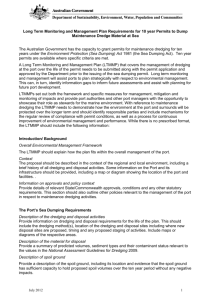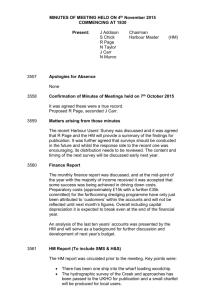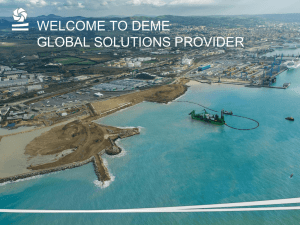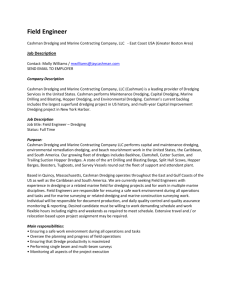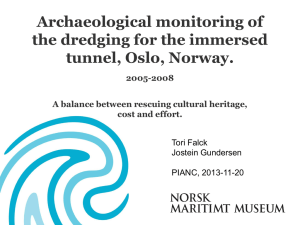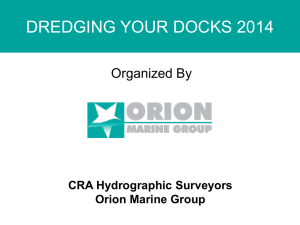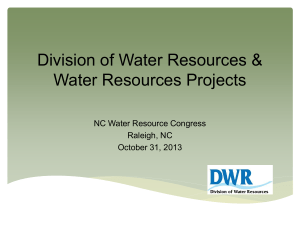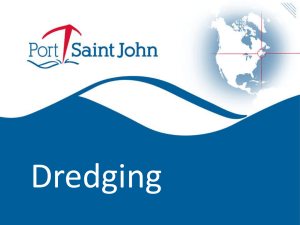Word - 129KB - Department of the Environment
advertisement
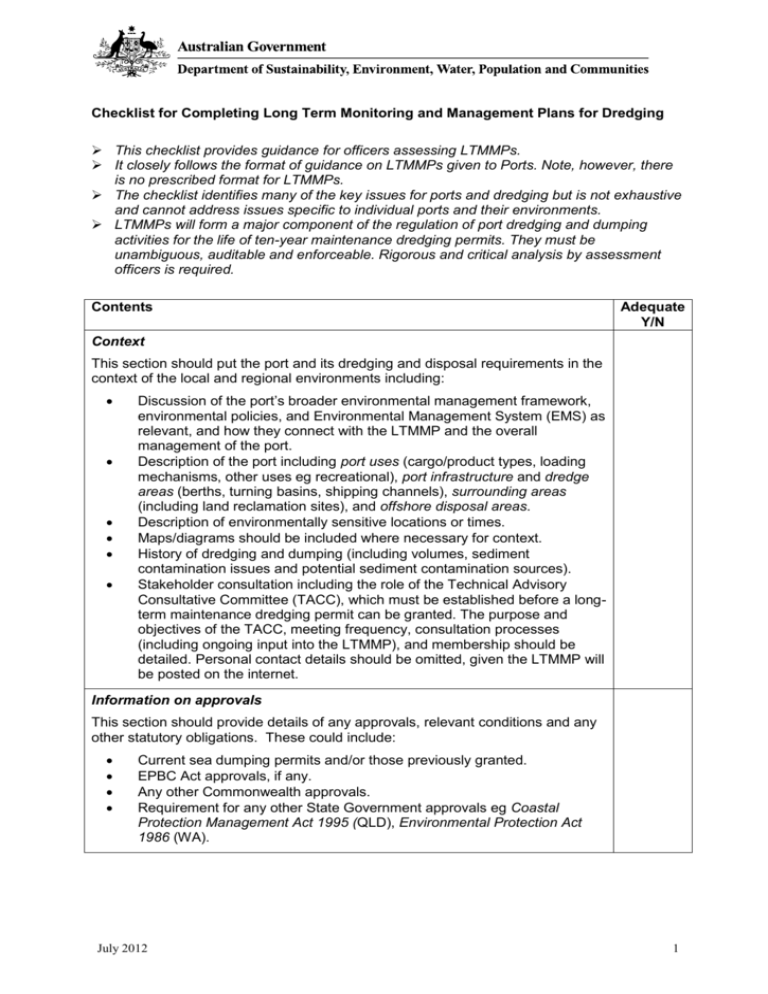
Checklist for Completing Long Term Monitoring and Management Plans for Dredging This checklist provides guidance for officers assessing LTMMPs. It closely follows the format of guidance on LTMMPs given to Ports. Note, however, there is no prescribed format for LTMMPs. The checklist identifies many of the key issues for ports and dredging but is not exhaustive and cannot address issues specific to individual ports and their environments. LTMMPs will form a major component of the regulation of port dredging and dumping activities for the life of ten-year maintenance dredging permits. They must be unambiguous, auditable and enforceable. Rigorous and critical analysis by assessment officers is required. Contents Adequate Y/N Context This section should put the port and its dredging and disposal requirements in the context of the local and regional environments including: Discussion of the port’s broader environmental management framework, environmental policies, and Environmental Management System (EMS) as relevant, and how they connect with the LTMMP and the overall management of the port. Description of the port including port uses (cargo/product types, loading mechanisms, other uses eg recreational), port infrastructure and dredge areas (berths, turning basins, shipping channels), surrounding areas (including land reclamation sites), and offshore disposal areas. Description of environmentally sensitive locations or times. Maps/diagrams should be included where necessary for context. History of dredging and dumping (including volumes, sediment contamination issues and potential sediment contamination sources). Stakeholder consultation including the role of the Technical Advisory Consultative Committee (TACC), which must be established before a longterm maintenance dredging permit can be granted. The purpose and objectives of the TACC, meeting frequency, consultation processes (including ongoing input into the LTMMP), and membership should be detailed. Personal contact details should be omitted, given the LTMMP will be posted on the internet. Information on approvals This section should provide details of any approvals, relevant conditions and any other statutory obligations. These could include: Current sea dumping permits and/or those previously granted. EPBC Act approvals, if any. Any other Commonwealth approvals. Requirement for any other State Government approvals eg Coastal Protection Management Act 1995 (QLD), Environmental Protection Act 1986 (WA). July 2012 1 Contents Adequate Y/N Description of the port’s sea dumping requirements This section should describe the port’s dredging and disposal activities, expected over the life of the LTMMP. While the LTMMP principally addresses maintenance dredging, Port authorities/companies should be encouraged to consider planned capital works and how they will impact on future maintenance dredging requirements and any environmental sensitivities (eg capital works pressures may inform research/monitoring priorities under LTMMP). Issues to be addressed: For the various dredge footprints eg berths, turning basin, channel: - predicted volumes required for offshore disposal (including explanation/rationale); - contaminant status under the National Assessment Guidelines to Dredging (2009) Description of dredging and disposal methodology (including expected dredge type) for life of the LTMMP, including location (dredging and disposal sites), staging and timing. Existing/current disposal sites, their sediment characteristics (including contaminant status) and whether the sites will have capacity for the dredged material over the life of the LTMMP. An approved Sediment Sampling and Analysis Plan (SAP), prepared in accordance with the NAGD and a SAP Report should be appended to the LTMMP, which should explain how the SAP will be implemented over the life of the Plan to maintain currency of valid data (ie five years or less). This should include ensuring valid current data is available for the next permit, meaning several sampling-analysis efforts will be required. The SAP (or LTMMP) should detail how it will be updated where maintenance dredging volumes (and sampling requirements) increase. The SAP/LTMMP should note that any amendments to the SAP will be approved by the Determining Authority prior to sampling. Description of the existing environment This section should characterise the dredging and disposal sites and adjacent areas including: Local and regional environment/existing habitat eg seagrass, corals, mudflats, rocky reefs, mangroves (include diagrams/pictures). Sensitive sites. Bathymetry. Climate. Current, tides, winds/waves. Water quality/turbidity including plume modelling. Marine Fauna eg whales, turtles, dugongs, migratory seabirds/shorebirds and the habitat value of the area (roosting, feeding, migrating etc). Recent surveys undertaken within the Port eg benthic habitats. Marine protected areas. Other users including recreational, indigenous/cultural resources. Maps and/or diagrams should be included where necessary for context. July 2012 2 Contents Adequate Y/N Description of potential impacts This section should address both short term and long term, direct and indirect impacts, and any uncertainties regarding the predicted impacts, including but not limited to the following: Direct removal/impact to benthic habitat in the vicinity of the spoil ground eg seagrass, corals. Increased turbidity and sedimentation. Exposure to contaminants – in sediments and water column. Coastal processes. Introduced marine pests. Hydrocarbon and chemical spills. Waste management. Noise (if applicable eg sensitive marine fauna). Lighting (if applicable eg turtle nesting). Vessel strike to marine species, including exclusion zones to be implemented during dredging and dumping. Management Actions Waste management strategies Waste management options/alternatives to sea disposal The majority of Australian ports have long established maintenance dredging and disposal activities. However, each permit assessment must assess the need for, and the practical alternatives to, sea disposal (see Annex 2 to the London Protocol). A permit assessment may conclude that there are some options for onshore disposal or it may be a preferred option in the future, for example, due to ongoing contaminant issues or increased pressure on environmental sensitivities, or due to the suitability of the material for reuse as construction grade fill. It may, therefore, be appropriate in some instances that the LTMMP address alternatives to sea disposal over the longer term. Waste prevention For ports where there are potential sediment contamination issues the LTMMP should address means of waste prevention, including the reduction of pollutants or the treatment of contaminated sediments. Port authorities should undertake a stewardship role, working with port users (eg bulk commodity exporters) to identify and manage pollutants, including improving practices over the life of the LTMMP. Environmental management strategies Environmental management strategies can be useful in defining the desired outcomes of the LTMMP and establishing performance objectives. Management strategies should target each of the potential environmental impacts identified through the assessment. Examples include: Reduce the need for offshore disposal of dredged material. Minimise the generation or migration of turbid plumes during dredging/dumping activities. Limit the direct or indirect loss of benthic habitats at the spoil ground. Minimise the risk of introduced marine pests. Minimise impacts on other users of the environment. Ensure hydrocarbons are handled and stored in a manner that minimises the potential impact on the environment through leaks, spills etc. July 2012 3 Contents Adequate Y/N Avoid impacts to marine fauna (such as mammals, turtles, fisheries etc.) resulting from dredging/disposal activities. Ensure best practice management for the handling and storage of all waste and hazardous materials related to the dredging. Management/Monitoring actions Management strategies form the basis for specific management and monitoring actions. It is particularly important that management actions are clear, auditable and enforceable. Examples include: Turtle exclusion devices. No overflow dredging at environmentally sensitive locations. Suspension of dredging during environmentally sensitive periods eg turtle nesting, coral spawning. Measures to suspend/relocate/modify dredging/dumping if defined turbidity monitoring levels are triggered. These requirements are to be assessed on a case-by-case basis and monitoring programs established for other projects within the port should be considered when assessing monitoring requirements. Trigger levels for suspension of dredging/dumping Continuous observations for marine species including exclusion zones/response measure to be implemented during dredging and dumping (vessel strike) eg 300m radius. Coral, seagrass health monitoring. Spoil ground monitoring – bathymetry (before and after dredging/dumping). Introduced Marine Pests eg Vessel arrival clearance procedures (AQIS/Ballast water), contingency measures in the event marine pests are detected. Spill response measures. Performance indicators Performance indicators are used to verify the effectiveness of the LTMMP and will indicate the success or otherwise of particular management measures. The indicators need to be clear and concise, and specify the outcome to be achieved. Examples of performance indicators can include: No injury or mortality incidents attributable to dredging for turtles and marine mammals. 100% compliance with all State and Commonwealth requirements relating to the management of marine pests. No injury or mortality to turtles or marine mammals resulting from drilling and blasting activities Zero incidents involving the loss of solid and hazardous waste into the marine environment as a result of the maintenance dredging and dumping. Corrective actions Corrective actions need to be outlined to demonstrate that appropriate methods will be implemented if there is a deviation from a management measure or if a management strategy is not achieved. The corrective action should be designed to prevent or mitigate any further impacts and should ensure that management strategies are achieved. The timeframe for implementation should be included. July 2012 4 Contents Adequate Y/N Examples include: Revision of dredging strategy, including potential relocation of the dredge(s) and alterations to operational mode if plumes exceed trigger levels established in the LTMMP (as part of the management/monitoring actions). Several turbidity trigger levels may be set, the first and second allowing for closer investigation and relocation of the dredge vessel, the third generally requiring stop works until new management actions have been established and agreed with the Determining Authority. 1. Note: Real time monitoring of turbidity is not a mandatory requirement. Contingency planning Although the management measures will cover most potential impacts, contingency arrangements are required in the event that management measures are (or are likely to be) ineffective in mitigating impacts. This failure is not the result of non-compliance with management measures (which is addressed through ‘corrective actions’) but can relate to human-induced impacts (eg oil spill, increased contaminant levels, cumulative effects from adjacent dredging projects) or natural extreme events (eg cyclone, floods). Contingency arrangements should be set out for reasonably foreseeable events. Continuous improvement The LTMMP should have as an objective, continuous improvement to prevent minimise or mitigate environmental impacts in the longer term. Examples include: Investigation of potential reuse of some/all dredged material. Commitment to manage potential contamination issues/sources within the Port. Port Authorities generally do not have the authority to regulate other port users. As a minimum the applicant should commit to reporting any incidents that may impact on the environment and in particular incidents that may contaminate sediment to the department and other appropriate authorities. Research/studies into impact of dredging on local populations of threatened species. Auditing requirements and reporting Auditing, or some other form of verification, and reporting of results (self and/or independent) should ensure that the objectives of the management plan are being achieved. The LTMMP should detail reporting and reviewing mechanisms to demonstrate compliance. Approval conditions may include the provision of reports or mandatory audits of conditions, including the plans required by these conditions. The management plan should provide a clear summary of all reporting and review requirements, including timing and submission to the Determining Authority. Responsible parties and the procedure for responding to non-compliances should be articulated. Reporting examples include: Annual dumping volume reporting (for subsequent government reporting to the International Maritime Organisation). Environmental Risk/Incident reporting (within 48 hours). Bathymetric survey reporting (within two months of completion of dredging campaign). July 2012 5 Contents Adequate Y/N Annual Coral Health /Water Quality. Responsibilities There should be a clear statement nominating the position(s) within the applicant’s organisation responsible for ensuring compliance with management actions, strategies, and other commitments within the LTMMP. This includes identification of the person’s position within the port or company. Ultimate responsibility, if there is a failure in implementation of the LTMMP, should be defined. Examples include: The dredge contractor is responsible for complying with the relevant management actions within the LTMMP. The port environmental manager is responsible for ensuring compliance with the LTMMP. The port manager is responsible for reporting to the Determining Authority. Induction and training of staff within the organisation to ensure understanding of and compliance with LTMMP. Review of the LTMMP The LTMMP should include a section which details how the review of the LTMMP will be undertaken, including where unanticipated environmental risks are identified and are of a nature that requires the Plan to be modified. This section should detail: Position(s) within the applicant’s organisation responsible for review and change. Triggers/timing for review. Consultation, including TACC process. This section should also state that reviewed or revised LTMMPs must be approved by the Department prior to being implemented. Publication of the LTMMP This section should outline how the Port will make the LTMMP available to the public, including via posting on the port/company website. The LTMMP should, ideally, commit to publishing monitoring results on the website. The Determining Authority may determine the latter is necessary for ports with particular environmental sensitivities or a high level of public concern. July 2012 6
